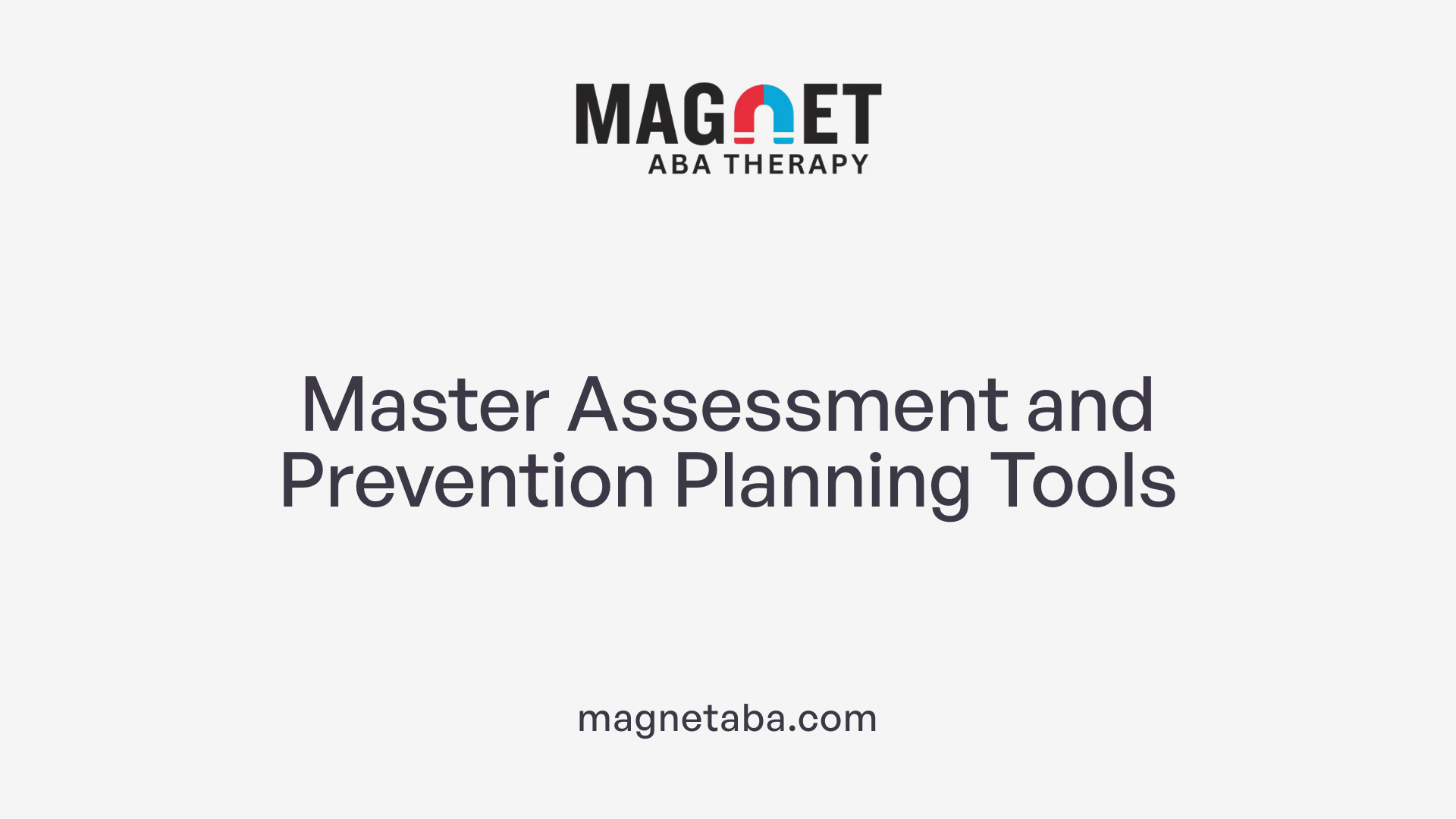Understanding Escape-Maintained Behaviors and Prevention Approaches
Escape-maintained behaviors are actions that individuals use to avoid or terminate unpleasant tasks or situations, often driven by negative reinforcement. Recognizing the underlying functions of these behaviors is essential for implementing effective prevention strategies. These behaviors, common in children with conditions like Autism Spectrum Disorder, can disrupt learning and social engagement if not properly addressed. A comprehensive, individualized approach combining proactive interventions and behavioral techniques is crucial for successfully minimizing escape behaviors.
Proactive Strategies to Prevent Escape Behaviors
What are effective strategies to prevent escape-maintained behaviors?
Preventing escape behaviors requires a thoughtful, individualized approach that targets the reasons behind a person's desire to escape or avoid certain tasks. One of the most effective methods is adjusting the difficulty of tasks to match the individual's skills. Breaking down larger tasks into smaller, more manageable steps can make work feel less overwhelming and more achievable.
Providing choices and clear schedules also plays a critical role. Offering options such as selecting the order of tasks or choosing materials helps give the individual a sense of control, reducing the likelihood of escape behaviors. Visual schedules can set clear expectations and routines, fostering predictability and security.
Incorporating personal interests and engaging activities makes learning more appealing and relevant. When activities align with the individual's preferences or hobbies, they are more motivated to participate, decreasing the need to escape.
Teaching functional communication skills is vital. Enabling individuals to request breaks, help, or alternatives through verbal or non-verbal means reduces frustration and provides appropriate outlets for their needs. Combining these communication strategies with reinforcement—such as praise or preferred items—encourages desirable behaviors.
Finally, using task modification like shortening activities, providing frequent breaks, and reinforcing positive responses creates a supportive environment. When strategies are implemented consistently and tailored to individual functions, they significantly decrease the chances of escape-maintained behaviors occurring, promoting engagement and positive participation.
Assessment and Prevention Planning Techniques

What are some behavior assessment and prevention planning techniques for escape-maintained behaviors?
Effective management of escape-maintained behaviors starts with a thorough understanding of why the behavior occurs. Behavioral assessment tools such as the Functional Behavior Assessment (FBA) and functional analysis (FA) are essential first steps. These assessments help identify environmental triggers and specific functions that the behavior serves, such as escaping non-preferred tasks or activities.
Once the function is understood, intervention strategies can be tailored to address the underlying reasons. Antecedent modifications play a vital role in this process. For example, adjusting task difficulty by breaking tasks into smaller, manageable parts or offering choices related to the activity can greatly reduce the motivation to escape. Incorporating visual schedules and cues helps set clear expectations, making the environment more predictable and less stressful for the individual.
Providing scheduled or non-contingent breaks—where breaks are given at fixed intervals regardless of behavior—can prevent the need for the individual to engage in escape behaviors. Teaching functional communication skills, such as requesting a break or help with picture cards or verbal cues, offers appropriate alternatives to escape actions.
Demand fading is another highly effective technique. This involves gradually increasing task difficulty or duration, allowing the individual to build tolerance over time, thereby reducing escape behaviors.
In addition to antecedent modifications, reinforcement strategies are crucial. Differential reinforcement of alternative behaviors (DRA) and functional communication training (FCT) help promote positive replacement behaviors. These methods involve reinforcing appropriate requests for breaks or assistance while withholding reinforcement for escape behaviors.
Further, schedule thinning—gradually increasing the time or effort required for reinforcement—and embedding alternative responses within routines help sustain behavior change. Combining all these strategies results in a comprehensive plan that prevents escape-maintained behaviors effectively, ensuring the individual’s needs are met while maintaining a positive learning environment.
Search query for more info: Behavior assessment and prevention strategies for escape behaviors
This holistic approach ensures that interventions are personalized, systematic, and sustainable, significantly reducing the likelihood of escape behaviors recurring.
Behavioral Interventions for Escape Maintenance

What are effective behavioral interventions for escape-maintained behaviors?
Addressing escape-maintained behaviors requires targeted strategies that focus on understanding and modifying the factors maintaining the behavior. One of the most prominent interventions is functional communication training (FCT). This approach teaches individuals to communicate their needs, such as requesting a break or help, in an appropriate manner. By replacing escape behaviors with appropriate communication skills, FCT allows the individual to gain what they want without engaging in problematic actions.
Environmental modifications also play a crucial role. Setting structured routines that include scheduled breaks, reducing task difficulty, and breaking tasks into manageable parts can reduce the motivation to escape. Allowing individuals to choose the order of tasks or materials increases their perceived control and engagement, reducing frustration that might lead to escape behaviors.
Visual supports like visual schedules and social stories help prepare children for upcoming activities or transitions. These tools set clear expectations, decrease uncertainty, and reduce anxiety, which often triggers escape behaviors. For example, a visual schedule can show the sequence of activities, indicating when breaks are permitted, thus discouraging impulsive escape attempts.
Reinforcing alternative, functional behaviors is essential. Techniques such as differential reinforcement of alternative behaviors (DRA) involve consistently providing praise or access to preferred items when the individual engages in acceptable ways to request a break or assistance. This positive reinforcement increases the likelihood of adaptive responses and diminishes reliance on challenging escape behaviors.
In addition to these strategies, individualizing interventions based on a thorough functional behavior assessment ensures that the interventions target the specific reasons for escape behaviors. Continuous data collection and collaboration with professionals like Board Certified Behavior Analysts (BCBAs) help tailor interventions to the individual's needs, ensuring effective outcomes.
Combining these approaches—functional communication training, environmental adjustments, visual supports, reinforcement, and personalized planning—creates a comprehensive framework to decrease escape-maintained behaviors and promote more functional, adaptive responses.
Using Schedule Thinning and Routine Adjustments
 When addressing escape-maintained behaviors, thoughtfully modifying routines and schedules can be highly effective. Schedule thinning involves gradually increasing the difficulty or duration of tasks and routines, giving individuals time to develop tolerance and reduce their desire to escape.
When addressing escape-maintained behaviors, thoughtfully modifying routines and schedules can be highly effective. Schedule thinning involves gradually increasing the difficulty or duration of tasks and routines, giving individuals time to develop tolerance and reduce their desire to escape.
One common method used in interventions is the implementation of chained schedules with embedded reinforcement. In this approach, individuals complete a series of steps or tasks before earning reinforcement. For example, a student might need to finish several shorter tasks linked together, with access to preferred items or activities provided after each segment or once the chain is complete. This method helps shift focus from escape behaviors to task completion by reinforcing each small success.
Demand fading and response delay are additional strategies used to extend tolerance for tasks. Demand fading involves systematically reducing the number or difficulty of demands initially, then gradually reintroducing them as compliance improves. For instance, starting with a simple request and slowly increasing complexity teaches the individual to withstand longer periods of task engagement without escaping.
Incorporating preferred stimuli into routines further supports compliance. Providing access to favored toys, activities, or sensory items as rewards during or between tasks encourages participation. For example, offering a break with a favorite activity as a reward after completing a task sequence reinforces positive behavior.
A planned, gradual increase in demands, known as demand fading, ensures that the individual builds endurance. This might involve starting with brief, easy tasks and progressively extending their length or complexity. Combining these tactics with functional communication training (FCT)—teaching appropriate ways to ask for breaks—can significantly reduce escape-maintained behaviors.
Overall, tailoring schedule thinning to each individual and consistently applying these principles helps foster independence, decrease avoidance behaviors, and promote a more adaptive routine setting.
Support for Caregivers and Practitioners
 Managing escape-maintained behaviors effectively requires a comprehensive approach involving caregivers and professionals alike. First, training and education are vital; caregivers and practitioners should be well-versed in conducting Functional Behavior Assessments (FBA). This helps identify the specific triggers for escape behaviors and their underlying function, such as avoiding non-preferred tasks.
Managing escape-maintained behaviors effectively requires a comprehensive approach involving caregivers and professionals alike. First, training and education are vital; caregivers and practitioners should be well-versed in conducting Functional Behavior Assessments (FBA). This helps identify the specific triggers for escape behaviors and their underlying function, such as avoiding non-preferred tasks.
Once the function is understood, implementing targeted strategies like functional communication training (FCT) allows individuals to request breaks or help appropriately, reducing maladaptive escape actions. Consistency in applying these interventions is crucial, which can be achieved through clear guidance, shared routines, and regular team meetings.
Monitoring progress with data collection helps determine what strategies are effective and when adjustments are needed. This ongoing evaluation supports a flexible approach—adapting strategies according to the individual’s response and changing environmental factors.
Collaboration among caregivers, educators, and behavioral specialists ensures that interventions are cohesive and tailored. Incorporating diverse perspectives and expertise enhances the effectiveness of the intervention plan.
In summary, empowering caregivers and practitioners through training, fostering consistent implementation, diligent monitoring, adaptive strategies, and teamwork creates an environment conducive to reducing escape-maintained behaviors and promoting positive engagement.
Holistic and Collaborative Approaches to Reduce Escape Behaviors
Reducing escape-maintained behaviors requires a comprehensive and individualized approach that combines proactive environmental modifications, functional communication training, schedule adjustments, and reinforcement strategies. Training caregivers and practitioners to implement these interventions consistently and flexibly is essential for long-term success. Functional behavior assessments facilitate targeted intervention planning, ensuring that strategies address each person's unique needs. Through collaborative efforts, employing evidence-based techniques, and continuously monitoring progress, educators and caregivers can foster more adaptive behaviors and improve overall learning and social engagement.
References
- Escape-Maintained Behaviors
- Function-Based Interventions for Escape-Maintained Problem ...
- What To Do When Escape Is The Behavior Function
- Treatment of Escape-Maintained Challenging Behavior Using ...
- [PDF] 3.6 - Proactive Strategies for Escape Maintained Behaviors - AWS
- What are Escape Behaviors?
- 3 Interventions to Decrease Escape Behaviors - Simply Special Ed
- Stopping Escape-Maintained Behaviors Before They Happen












